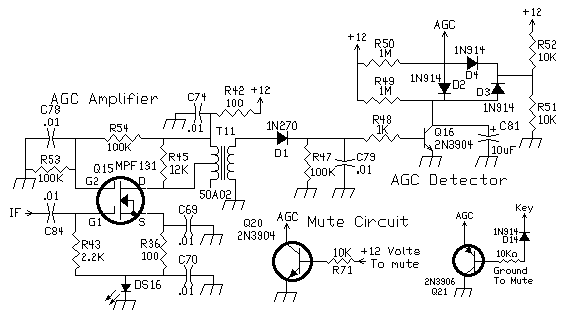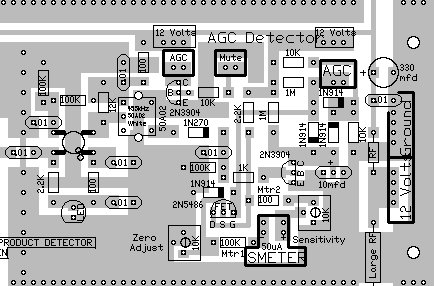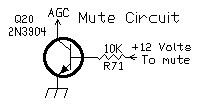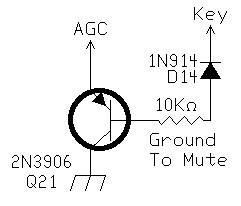



|
This circuit was taken from the Progressive Communications Receiver, and works very well. Its simplicity is what I consider its greatest value. The mute circuit was added on the Rev2 boards. Putting 12 volts at the "Mute" box mutes the receiver. The mute circuit includes the 2N3904 and the 10K resistor. No control is available for adjusting the AGC threshold, but the circuit in the Progressive Communications Receiver shows how to install one. With wide traces and plenty of ground plane available, the modification should be very easy. I have used this circuit for higher IF frequencies, but its loses AGC action the higher the IF frequency. The Progressive Receiver uses it at 9 MHz, but I have found that is about the high limit of its usefulness. Above 10MHz, an additional amplifier is needed. At 455kHz it is unbeatable. Substituting a 2N5486 for the 2N3904 will increase sensitivity considerably, but it is difficult to get a linear curve for signal level vs. AGC action with FETs. The 1N270 is the best detector diode I have found, as it has the lowest forward voltage drop of any of the popular diodes out there, about .3 volt, and is easily obtained. Circuit DescriptionIt is somewhat of a brain teaser to figure out the circuit. The two diodes connected to the 10K resistors, one going to ground and the other to 12 Volts, keep the voltage at both the collector of the transistor and gate 2 of the MOSFETs at 1/2 the supply voltage (approximately 6 volts). Both circuits are fed with 1 megohm resistors. The 1 megohm resistors and the 10 mfd capacitor (C81) set the response times. Action is very fast on CW, and full break-in CW operation is a snap. There is a tendency for popping on very strong signals, but if this is objectionable, the "Gain Adjust" control at the first VFO amplifier can be lowered to eliminate the popping. The easiest way to change the response time is to experiment with the 10mfd capacitor (C81) on the collector of the 2N3904. Hang AGCA nice option for the AGC would be a hang AGC circuit. There is one already out there close to the design of this circuit in the article "Solid-State Hang AGC Circuit", by Jerome L. Hartke, W1ERJ, Ham Radio, September 1972, pp 50. The subtitle of the article "A high performance solid-state hang AGC circuit for use with FET and MOSFET RF circuits" gives the gist of the article. His description of the circuit on page 52 of the article: "By properly choosing the RC time constants in the circuit, receiver gain is quickly reduced as a signal appears (no unpleasant thumps caused by slow attack time constants). The gain then stays absolutely constant between voice syllables or code characters (the S-meter doesn't even wiggle), but recovers rapidly enough after the hang time to follow fading signals or weak stations in a roundtable." This circuit might be an interesting modification to the AGC circuit, if some circuit guru can figure out how to incorporate it into the receiver. There are plans to work on this circuit when time becomes available. Mute CircuitThe mute circuit using a 2N3904 uses a +12V to mute the IF strip. The circuit is shown in the bottom left corner of the schematic at the top if the page. However, sometimes it is difficult to easily generate a positive 12V for muting.  By using a 2N3906, reversing its mounting, putting the flat side where it shows the curved side, makes it a circuit that activates mute with a ground. Much easier to do when tied into the key with a diode. The 10K resistor is also used to the base. The diode can be tack soldered to the end of the 10K resistor and a clip lead from it to the key - assuming that the key is grounded to send CW with the transmitter. The diode isolates the mute circuit from anything else connected to the key. The band end goes to the key.  For further study of the circuit in the receiver, check out the Progressive Communications Receiver in most of the 1980's ARRL Handbooks. |
|
|
|
|
Send E-Mail || Amateur Radio Receivers || Electoluminescent Receiver || Back to Basic Instructions

